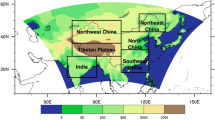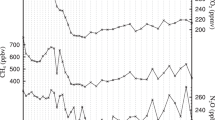Abstract
We explore climate-vegetation interactions in mid-Holocene North Africa with a suite of community climate system model (CCSM2) simulations. The CCSM includes synchronously coupled atmosphere, ocean, sea ice, land, and vegetation models. The CCSM’s present-day precipitation for North Africa compares well with simulations of other models and observations. Mid-Holocene data reveal a wetter and greener Sahara compared to the present. The CCSM exhibits a greater, closer to the expected, precipitation increase than other models, and in response, grasses advance from 18.75° to 22.5°N in much of North Africa. Precipitation is enhanced locally by the northward advance of grasses, but suppressed regionally mainly due to an insufficient albedo decrease with the expansion of vegetation. Prior studies have always lowered the surface albedo with the expansion of vegetation in North Africa. In the CCSM’s mid-Holocene simulations, the albedo decreases more because wetter soils are simulated darker than drier soils than due to expanding vegetation. These results isolate albedo as the key ingredient in obtaining a positive precipitation-vegetation feedback in North Africa. Two additional simulations support this conclusion. In the first simulation, the desert’s sandy soil textures are changed to loam to represent increased organic matter. Soil water retention and grass cover increase; albedo decreases somewhat. Precipitation responds with a small, yet widespread, increase. In the second simulation, a darker soil color is prescribed for this region. Now the monsoon advances north about 4°. These results illustrate a North African monsoon highly sensitive to changes in surface albedo and less sensitive to changes in evapotranspiration.






Similar content being viewed by others
References
Berger A, Loutre M-F (1991) Insolation values for the climate of the last 10 million years. Q Sci Rev 10:297–317
Blackmon M et al (2001) The community climate system model. B Am Meteorol Soc 82:2357–2376
Bonan GB, Oleson KW, Vertenstein M, Levis S (2002a) The land surface climatology of the community land model coupled to the NCAR community climate model. J Clim 15:3123–3149
Bonan GB, Levis S, Kergoat L, Oleson KW (2002b) Landscapes as patches of plant functional types: an integrating concept for climate and ecosystem models. Global Biogeochem Cycles 16. DOI 10.1029/2000GB001360
Bonan GB, Levis S, Sitch S, Vertenstein M, Oleson KW (2003) A dynamic global vegetation model for use with climate models: concepts and description of simulated vegetation dynamics. Global Change Biol 9:1543–1566
Bonfils C, Lewden D, Taylor KE (1998) A summary documentation of the PMIP models, PCMDI Report. http://www-lsce.cea.fr/pmip
Bonfils C, de Noblet-Ducoudré N, Braconnot P, Joussaume S (2001) Hot desert albedo and climate change: mid-Holocene monsoon in North Africa. J Clim 14:3724–3737
Braconnot P, Joussaume S, Marti O, de Noblet N (1999) Synergistic feedbacks from ocean and vegetation on the African monsoon response to mid-Holocene insolation. Geophys Res Lett 26:2481–2484
Braconnot P, Loutre M-F, Dong B, Joussaume S, Valdes P, PMIP participating groups (2002) How the simulated change in monsoon at 6 ka BP is related to the simulation of the modern climate: results from the Paleoclimate Modeling Intercomparison Project. Clim Dyn 19:107–121
Briegleb BP, Hunke EC, Bitz CM, Lipscomb WH, Holland MM, Schramm JL, Moritz RE (2004) The sea ice simulation of the Community Climate System Model, version two. NCAR Technical Note NCAR/TN-455 + STR, p 34
Broström A, Coe MT, Harrison SP, Gallimore R, Kutzbach JE, Foley JA, Prentice IC, Behling P (1998) Land surface feedbacks and palaeomonsoons in Northern Africa. Geophys Res Lett 25:3615–3618
Carrington DP, Gallimore RG, Kutzbach JE (2001) Climate sensitivity to wetlands and wetland vegetation in mid-Holocene North Africa. Clim Dyn 17:151–157
Charney JG (1975) Dynamics of deserts and drought in the Sahel. Q J R Met Soc 101:193–202
Charney JG, Quirk WJ, Kornfield J (1977) A comparative study of the effects of albedo change in drought in semi-arid regions. J Atmos Sci 34:1366–1385
Claussen M, Gayler V (1997) The greening of the Sahara during the mid-Holocene: results of an interactive atmosphere-biome model. Global Ecol Biogeogr 6:369–377
Coe MT, Bonan GB (1997) Feedbacks between climate and surface water in northern Africa during the middle Holocene. J Geophys Res 102:11087–11101
Collins WD, Hackney JK, Edwards DP (2002) An updated parameterization for infrared emission and absorption by water vapor in the National Center for Atmospheric Research Community Atmosphere Model. J Geophys Res Atmos 107:4664
Crowley TJ, North GR (1991) Paleoclimatology. Oxford University Press, New York, p 349
Doherty R, Kutzbach JE, Foley JA, Pollard D (2000) Fully coupled climate/dynamical vegetation model simulations over Northern Africa during the mid-Holocene. Clim Dyn 16:561–573
Fluckiger J, Dallenbach A, Blunier T, Stauffer B, Stocker TF, Raynaud D, Barnola J-M (1999) Variations in atmospheric N2O concentration during abrupt climatic changes. Science 285:227–230
Harrison SP et al (1998) Intercomparison of simulated global vegetation distributions in response to 6 kyr BP orbital forcing. J Clim 11:2721–2742
Hewitt CD, Mitchell JFB (1998) A fully coupled GCM simulation of the climate of the mid-Holocene. Geophys Res Lett 25:361–364
Hoelzmann P, Jolly D, Harrison SP, Laarif F, Bonnefille R, Pachur HJ (1998) Mid-Holocene land-surface conditions in northern Africa and the Arabian Peninsula: a data set for the analysis of biogeophysical feedbacks in the climate system. Global Biogeochem Cycl 12:35–51
Holland M (2003) The North Atlantic oscillation-Arctic oscillation in the CCSM2 and its influence on Arctic climate variability. J Clim 16:2767–2781
Ice Core Working Group (1998) Ice core contributions to global change research: past successes and future directions. The National Ice Core Laboratory, University of New Hampshire, p 48 . Available online at http://www.nicl-smo.sr.unh.edu/documents/1998/icwghtml.html
Indermuhle A et al (1999) Holocene carbon-cycle dynamics based on CO2 trapped in ice at Taylor Dome, Antarctica. Nature 398:121–126
Irizarry-Ortiz MM, Wang G, Eltahir EAB (2003) Role of the biosphere in the mid-Holocene climate of West Africa. J Geophys Res 108(D2):4042. DOI: 10.1029/2001JD000989
Jolly D et al (1998) Biome reconstruction from pollen and plant macrofossil data for Africa and the Arabian Peninsula at 0 and 6000 years. J Biogeogr 25:1007–1027
Joussaume S et al (1999) Monsoon changes for 6000 years ago: results of 18 simulations from the Paleoclimate Modeling Intercomparison Project (PMIP). Geophys Res Lett 26:859–862
Joussaume S, Taylor KE (1995) Status of the Paleoclimate Modeling Intercomparison Project (PMIP). In: Proceedings of the 1st international AMIP Scientific conference, Monterey. WCRP Report 92:425–430
Kiehl JT, Gent PR (2004) The community climate system model, version 2. J Clim (in press)
Kutzbach JE, Guetter PJ (1986) The influence of changing orbital parameters and surface boundary conditions on climate simulations for the past 18000 years. J Atmos Sci 43:1726–1759
Kutzbach JE, Bonan GB, Foley JA, Harrison SP (1996) Vegetation and soil feedbacks on the response of the African monsoon to orbital forcing in the early to middle Holocene. Nature 384:623–626
Legates DR, Willmott CJ (1990) Mean seasonal and spatial variability in gauge-corrected, global precipitation. Int J Climatol 10:111–127
Levis S, Foley JA, Pollard D (1999) Potential high-latitude vegetation feedbacks on CO2-induced climate change. Geophys Res Lett 26:747–750
Levis S, Bonan GB, Vertenstein M, Oleson KW (2004) The Community Land Model’s dynamic global vegetation model (CLM-DGVM): technical description and user’s guide. NCAR Technical Note NCAR/TN-459 + IA, p 50
Mikolajewicz U, Scholze M, Voss R (2003) Simulating near-equilibrium climate and vegetation for 6000 cal. years BP. Holocene 13:319–326
de Noblet-Ducoudré N, Claussen M, Prentice IC (2000) Mid-Holocene greening of the Sahara: first results of the GAIM 6000 year BP experiment with two asynchronously coupled atmosphere/biome models. Clim Dyn 16:643–659
Oleson KW, Bonan GB, Schaaf C, Gao F, Jin Y, Strahler A (2003) Assessment of global climate model land surface albedo using MODIS data. Geophys Res Lett 30:1443. DOI:10.1029/2002GL016749
Oleson KW, Dai Y et al (2004) Technical description of the Community Land Model (CLM). NCAR technical note NCAR/TN-461 + STR, National Center for Atmospheric Research, Boulder, p 174
Pollard D, Bergengren JC, Stillwell-Soller LM, Felzer B, Thompson SL (1998) Climate simulations for 10000 and 6000 years BP using the GENESIS global climate model. Paleoclimates 2:183–218
Prentice IC, Jolly D, BIOME 6000 participants (2000) Mid-Holocene and glacial-maximum vegetation geography of the northern continents and Africa. J Biogeogr 27:507–519
Smith R, Gent P (eds) (2002) Reference manual for the Parallel Ocean Program ocean component of the Community Climate System Model (CCSM2.0). Available online at http://www.ccsm.ucar.edu/models
Street FA, Grove AT (1976) Environmental and climatic implications of late Quaternary lake-level fluctuations in Africa. Nature 261:385–390
Texier D et al (1997) Quantifying the role of biosphere-atmosphere feedbacks in climate change: coupled model simulations for 6000 years BP and comparison with paleodata for northern Eurasia and northern Africa. Clim Dyn 13:865–882
Wang Z, Zeng X, Barlage M, Dickinson RE, Gao F, Schaaf CB (2004) Using MODIS BRDF and albedo data to evaluate global model land surface albedo. J Hydrometeorol 5:3–14
Willmott CJ, Matsuura K (2000) Terrestrial air temperature and precipitation: monthly and annual climatologies. Available online at http://climate.geog.udel.edu/~climate
Acknowledgements
We thank Dr. Martin Claussen and two anonymous reviewers for their constructive comments. The National Science Foundation sponsors the National Center for Atmospheric Research.
Author information
Authors and Affiliations
Corresponding author
Rights and permissions
About this article
Cite this article
Levis, S., Bonan, G.B. & Bonfils, C. Soil feedback drives the mid-Holocene North African monsoon northward in fully coupled CCSM2 simulations with a dynamic vegetation model. Climate Dynamics 23, 791–802 (2004). https://doi.org/10.1007/s00382-004-0477-y
Received:
Accepted:
Published:
Issue Date:
DOI: https://doi.org/10.1007/s00382-004-0477-y




